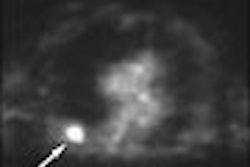MIAMI BEACH, FL - Dual contrast-enhanced MRI provides better sensitivity than FDG-PET for the detection of small liver metastases, according to data presented at the American Roentgen Ray Society meeting.
"Contrast enhanced MR detected significantly more lesions and more, smaller lesions in liver outcome in patients with colorectal cancer," said Dr. Sanjeeva Kalva during a talk Wednesday. Kalva is from Massachusetts General Hospital in Boston.
Kalva's group enrolled 34 patients with primary malignancy of the colon (27 patients) and pancreas (7). They underwent pre-contrast MRI, contrast-enhanced, T1-weighted MR with gadolinium and MnDPDP (Teslascan, Amersham Health, Buckinghamshire, U.K.), as well as FDG-PET.
Both MRI and PET images were analyzed by two experienced radiologists independently. They utilized surgical resection and intra-operative ultrasound or image-guided biopsy results to validate the imaging results. McNemar’s test was used for comparison with a p value of less than 0.05 deemed "significant."
Overall, 30 patients had metastases and four had no sign of metastasis. Ninety-seven metastases were evident with 33 of them measuring less than 1 cm. Dual-contrast MRI detected metastases in 29 patients, and 79 out of 97 metastases. Of these, 39 measured less than 1 cm.
In contrast, FDG-PET results were positive for malignancy in 31 patients, of which 28 were true-positive. This modality detected only 65 out of 97 metastases with a dozen measuring less than 1 cm. Of the 32 out of 97 lesions missed on PET, 21 measured less than 1 cm.
Based on the per-patient analysis, dual-contrast MRI had a sensitivity of 96.6% compared to 93.3% with PET. MR imaging had 100% positive predictive value (PPV) and an accuracy of 97.1%. FDG-PET turned in a PPV of 90.3% and an accuracy of 85.3%. The Analyzing per lesion, he found that MRI showed a sensitivity of 81.4% versus 67% with PET.
Based on the per-lesion analysis, the sensitivity of dual-contrast MRI was 81.4% versus 67% for FDG-PET. The PPV was 89.8% for MRI and 81.3% for FDG-PET and the accuracy was 75.5% for MRI and 64.1% for FDG-PET.
Because dual contrast MR exams detected significantly more metastases than PET (p = 0.0038), Kalva suggested that clinicians consider using the modality in this particular patient population.
By Jerry IngramAuntMinnie.com contributing writer
May 7, 2004
Related Reading
Radioactive microsphere therapy an option for liver cancer with poor portal flow, April 29, 2004
MRI abnormalities seen in patient with posttransplant transient mutism, March 31, 2004
Radiofrequency ablation effectively treats large liver tumors, March 22, 2004
Doppler ultrasound indices come up short in liver disease assessment, February 26, 2004
Copyright © 2004 AuntMinnie.com



















